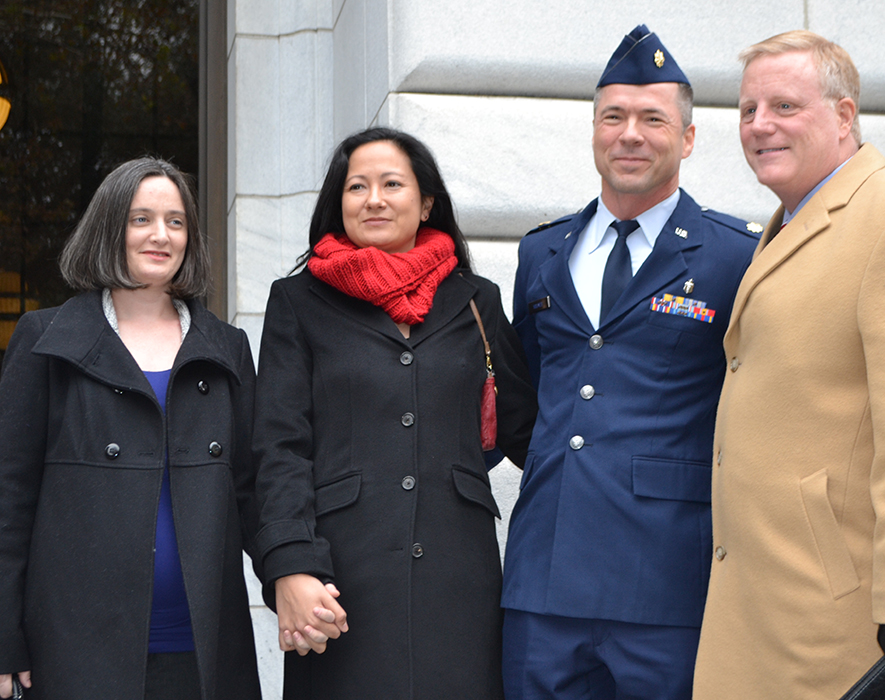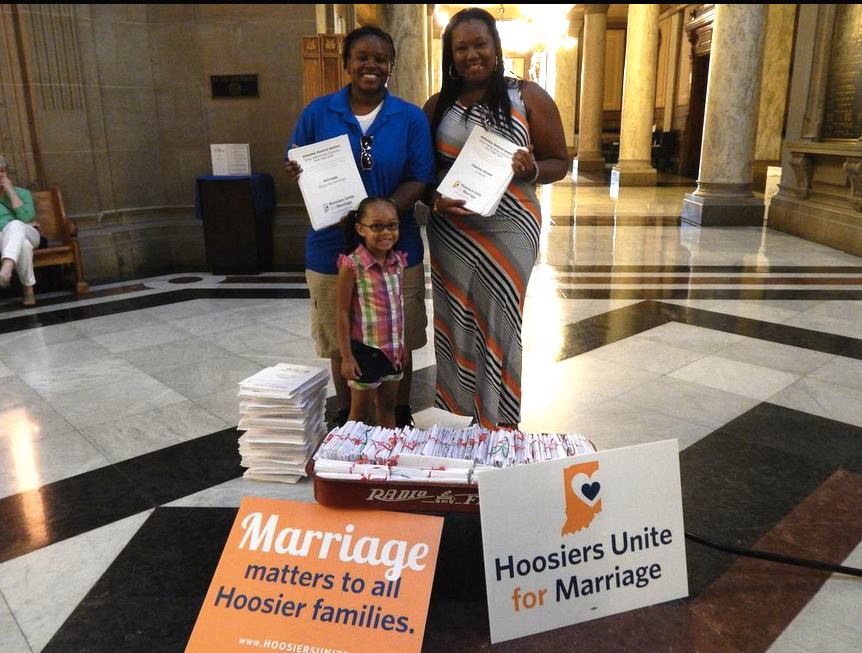Winning in Court
Many people presume that judges issue rulings in court based simply on the facts at hand, without public opinion playing any role at all. However, history tells us that how judges read laws and constitutions very much reflects where public opinion is (or, at least, what they think the public will accept). Leading up to the final Supreme Court marriage victory, Justice Ruth Bader Ginsburg said in an interview that “there hasn’t been any major change…in which there wasn’t a groundswell among the people before the Supreme Court put its stamp of approval on the inclusion in the equality concept of people who were once left out.”
Freedom to Marry's strategy was to marshal and invest energy and resources in making as strong a case in the court of public opinion as our advocates and plaintiffs were also making in the court of law.
That’s why Freedom to Marry’s strategy – while always building toward a win in the Supreme Court, and very much embracing litigation as a key methodology – was to marshal and invest energy and resources in making as strong a case in the court of public opinion as our advocates and plaintiffs were also making in the court of law. Here’s a look at key tactics we employed to creating the climate to win and hold victories in the courts.
Litigation was the pathway to the freedom to marry in many states. It often takes a judge to challenge prevailing assumptions (and even prejudice) that political decision-makers such as legislators or voters may be more unwilling to overcome. Early on, we won in state courts, first in Hawaii in the 1990s, then in Massachusetts, California, Connecticut, and Iowa. Later, we won in federal court, first in California, then in Utah, Oklahoma, and beyond, all the way up to the Supreme Court. In total, 25 of our final state victories (aside from the 13 final states we won at the U.S. Supreme Court) came through judicial rulings – 5 in state court and the rest in federal court. Most of these court wins came through our movement’s legal arm – the American Civil Liberties Union, Gay & Lesbian Advocates & Defenders, Lambda Legal, and the National Center for Lesbian Rights – while a significant share were initiated by private attorneys and assisted by growing numbers of law firms eager to join in the progress. Several of these victories, though, were stripped away by political attack, and most of them would not have happened had we not built momentum in public understanding and even the politics of the marriage debate, creating the climate for the courts to rule in our favor and ensure that the public and elected officials would accept the outcome.
Overall Lessons Learned
- Prepare to defend court victories politically: Winning in court often isn’t enough, as opponents can mount attempts through legislatures or at the ballot to reverse good decisions and otherwise try to delegitimize the win. State constitutional amendments nullified court victories in Hawaii in the 1990s and stripped away the freedom to marry in California in 2008. Advocates should be completely prepared to fight back against efforts to overturn the rulings, and should also work post-victory to allay concerns, refute falsehoods, and solidify support so as to leverage the win. In Massachusetts, for example, the Massachusetts Supreme Judicial Court victory on the freedom to marry was immediately followed by attempts in the legislature to pass a constitutional amendment repealing the freedom to marry. Without the strong leadership of MassEquality, supported by national groups and funders, and many months of public education work and organizing across the state, the nation’s first marriage state could have been a short-lived triumph. Similarly, in New Mexico in 2013, we prepared for an eventual state Supreme Court ruling on marriage by launching one of our joint campaigns, New Mexico United for Marriage, focused singularly on protecting the ruling, organizing in the legislature, and directing state-wide attention to the joy brought on by the freedom to marry.

As often as possible (as we did with the plaintiffs in Texas, Mark Phariss & Vic Holmes and Cleo & Nicole Dimetman-DeLeon) Freedom to Marry would work with private legal teams or our movement partners to write in-depth profiles and stories about the plaintiffs involved in the legal cases. By spotlighting their story in this way, we were able to extend the reach of the case and allow thousands more to connect with the personal reasons behind fighting for the freedom to marry.
- Tell the story behind the litigation: At the heart of litigation efforts are stories of injustice to real people. Our campaigns have sought to use the emotional resonance of the injustice of real stories as crucial ways to make our case and grow support. Edie Windsor in the DOMA case was a compelling figure – and with a smart media strategy behind her, her story became a face of the injustice of DOMA and the need to dismantle it once and for all. While the media loves covering the ins and outs of the court process and politics, what moves hearts and minds are people’s actual stories. It’s certainly wise to elevate the story that’s being discussed in the litigation. It’s also wise to identify and amplify similar stories of injustice in the state and across the country similar to the story being considered in court.
- Support legal teams with “friend-of-the-court” briefs: Amicus briefs (“friend-of-the-court” briefs) can be filed by groups that seek to expand on legal teams’ arguments or bring an additional perspective to the conversation. During marriage legal cases, state and national partners often came together to line up robust amici briefs, and as marriage work shifted overwhelmingly to the courts in 2014, a significant amount of work involved enlisting signers. Hand-in-hand with our legal advocacy organizations Freedom to Marry worked to enlist signers who could demonstrate most powerfully that America was ready for marriage nationwide. This included Republican officials, faith leaders, businesses, first responders, and mayors. During these court cases, we generated media and public discussion by highlighting the numbers and prominence of signers on amicus briefs, and putting forward their business/public health/faith, etc., case for ending marriage discrimination.

In 2014 and 2015, State campaigns would drive constituent action around ongoing litigation by urging supporters to sign petitions asking the Attorney General to stop defending marriage discrimination, a tactic that always garnered great press coverage.
- Focus field organizing on creating media moments: Litigation-related field efforts should focus on creating media moments that demonstrate support, highlight harms, and create a climate for victory. Freedom to Marry worked with state organizations in litigation states to organize groupings of supporters that we knew would be newsworthy—Florida First Responders for the Freedom to Marry, Texas Faith Leaders for the Freedom to Marry, etc. Another tactic that created a media moment was launching petitions urging state attorneys general to drop their defense of anti-marriage laws (we’d pursue this only after consultation with the litigation team). The petitions – which always ended with an in-person drop-off featuring children of same-sex couples, adorably wrapped petitions, and families who needed the freedom to marry – were a creative way to build online buzz for the court cases, give supporters a way to get involved with the legal case, and earn some strong media attention that underlined the overarching messages of the campaign. We’d look to identify the most compelling personal stories that we thought might impact the public. Additionally, we’d organize Town Hall meetings as a focus point to gather supporters and provide a platform for newsworthy supporters and people with compelling stories.
- Ensure that all media moments get maximum media coverage. Oftentimes, state LGBT groups simply didn’t have the capability to shape an opportunity for the press, pitch the story, and secure solid coverage in print and broadcast media. As a result, Freedom to Marry created an in-house capacity to do just that. We’d work with local organizers and attorneys to shape opportunities and maximize likelihood of coverage. In certain states, like Wyoming, this resulted in several strong, front-page stories in the state’s most important newspaper as we rolled out a list of prominent Republicans and clergy who were in support of the freedom to marry. We’d ensure that signers onto amicus briefs who we knew were newsworthy were available to speak to the press, sometimes holding media calls with key amici and other times offering exclusive stories to key outlets. And we’d work closely with the legal teams, local reporters covering the legal cases, and editorial boards to ensure they had access to attorneys and plaintiffs at key moments (deadlines for filing briefs, lead-up to oral arguments, etc.), had the chance to ask questions, and understood our side of the case. And in every situation, once we’d secure a news story, positive editorial, or powerful broadcast piece, we’d amplify it through our Digital Action Center.
- Produce and air television ads to showcase overarching messages and powerful messengers. One powerful way to generate earned media and drive the narrative while a court case is pending is by airing a television commercial highlighting a poignant story or a powerful messenger. During federal court consideration of lawsuits in the Mountain West, we aired a television spot featuring retired U.S. Senator Alan Simpson speaking about the western and Republican values that were important to him and how they led him to support the freedom to marry. In Tennessee, we aired a spot featuring a gay Navy officer who had just served in Afghanistan and yet couldn’t marry his partner in his home state. In Texas, through our Texas for Marriage campaign, we featured the voices of non-gay police officers standing beside a gay colleague in support of his freedom to marry. For each of these, we did relatively small media buys, with the goal of getting coverage of the spot on television news and in print. Because the stories were both so powerful, for a relatively small investment in airing the spot, we received solid earned media coverage.
States That Won the Freedom to Marry through Litigation
- 2004: Massachusetts
- 2009: Connecticut, Iowa
- 2013: California, New Jersey, New Mexico
- October 6, 2014: Colorado, Indiana, Kansas, North Carolina, South Carolina, Oklahoma, Utah, Virginia, West Virginia, Wisconsin, Wyoming
- October 7, 2014: Alaska, Arizona, Idaho, Nevada, Montana
- Early 2015: Florida, Alabama
- 2015 (with final Supreme Court victory): Arkansas, Georgia, Kentucky, Louisiana, Michigan, Mississippi, Missouri, Ohio, Nebraska, North Dakota, South Dakota, Tennessee, Texas